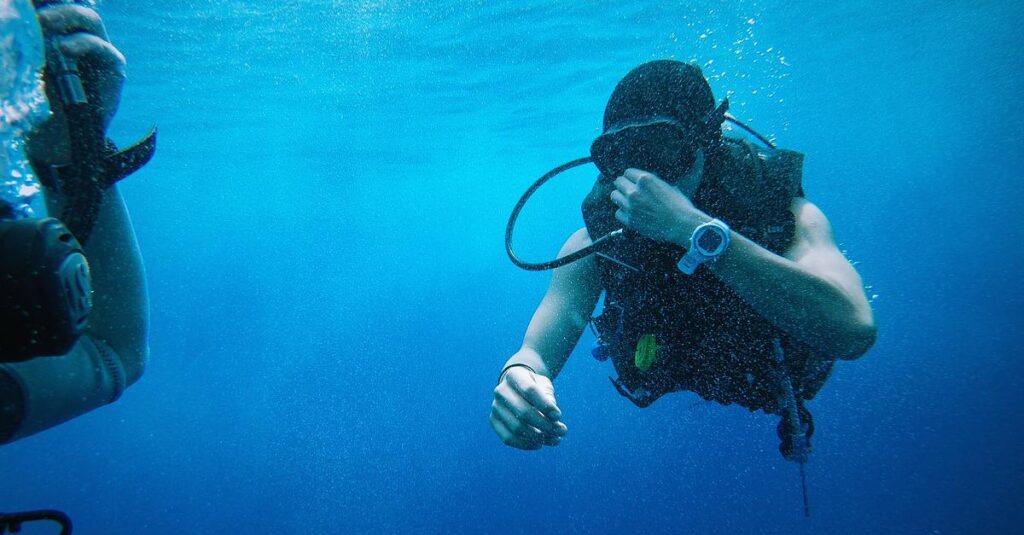

Scuba diving every day is tempting, especially if you’re on vacation and want to take every opportunity you have to experience the wonders of diving.
You can scuba dive every day, but you must take time in between to allow for adequate off-gassing. Without taking a break, nitrogen builds up in your body and can lead to major issues such as decompression sickness (DCS).
Daily diving ties to many other concerns, and there are different rules to follow when diving multiple days in a row or multiple dives a day. Keep reading to explore the risks of repetitive diving and how you can dive as much as possible while avoiding these issues.
How Many Days in a Row Can You Dive?
The number of days in a row you can dive depends on the intensity of your daily dives, but a good general rule is to take off 1 day per week. Most divers on liveaboards follow this rule.
This, along with following proper time at the surface, gives your body more than enough time to deal with any residual nitrogen that has built up. It may seem like overkill when getting down and dirty with calculations, but it’s better to be safe than sorry in this matter.
Can You Dive Multiple Times in One Day?
You can dive multiple times in one day. This is safer and easier for those with more diving experience, and it’s not recommended for new divers or those who are out of shape.
Diving multiple times a day will build the nitrogen levels in your body. While you’re taking breaks that allow you to off-gas a little, the chances of off-gassing completely within a 24-hour period means each repetitive dive should be shorter and not as deep.
What Happens If You Dive Too Much?
The main concern with diving too much is Decompression Sickness (DCS). This is a condition that occurs due to gas bubbles that form during your dive. When they are not allowed enough time in between dives to reabsorb (off-gas), they get trapped in the body (usually in joints).
DCS is not lethal, but it can be. When it occurs, the gas bubbles are liberated from your blood and tissues, and it can cause symptoms such as:
- Fatigue
- Aches or pain in your joints and muscles
- Clouded cognitive function
- Numbness and/or weakness (including paralysis)
- Rash
- Poor coordination or balance
Symptoms usually resolve within 24 hours, but you should seek medical attention and avoid both diving for about a month after to prevent reoccurrence. Active treatment usually involves hyperbaric oxygen therapy, and you should focus on rest and hydration during treatment.
How Long Should You Wait Between Dives?
The time you need to wait between dives varies depending on:
- The depth and duration of the previous dive
- The depth and duration of the next dive
- Any other plans you have for the day
Any time less than 10 minutes at surface does not count for degassing purposes, and most suggest you wait at least 1 hour before getting back into the water.
Surface Intervals
The easiest ways to determine how much time you need to spend at the surface between two dives is to look at the PADI RDP table or use a dive computer. Dive computers automatically take in your information and calculate the safest logistics moving forward, while the dive table requires a more hands on approach.
The RDP is to be used to plan recreational dives on air only. It actually includes 3 tables:
- Table 1: No Decompression Limits and Group Designation
- Table 2: Surface Interval Credit Table
- Table 3: Repetitive Dive Table
The first table helps you calculate which pressure group you are in following your first dive, while the second lets you recalculate your pressure group using the amount of time you spent at the surface off-gassing. The third table calculates your Adjusted No Decompression Limit and your Residual Nitrogen Time.
A dive course explains in greater depth how you can use a dive table to plan repetitive dives. In short, the first table assigns you a certain group based on your initial dive, and the second reassigns you to a new group depending on your surface interval. The third table then tells you how long you can stay at a certain depth depending on your pressure group rating.
References
https://www.ncbi.nlm.nih.gov/pmc/articles/PMC4244896/’
https://www.a1scubadiving.com/wp-content/uploads/2018/06/PADI-Recreational-Dive-Table-Planner.pdf
http://www.scuba-tutor.com/decompression/surface-intervals/
https://www.healthywa.wa.gov.au/Articles/A_E/Decompression-illness
